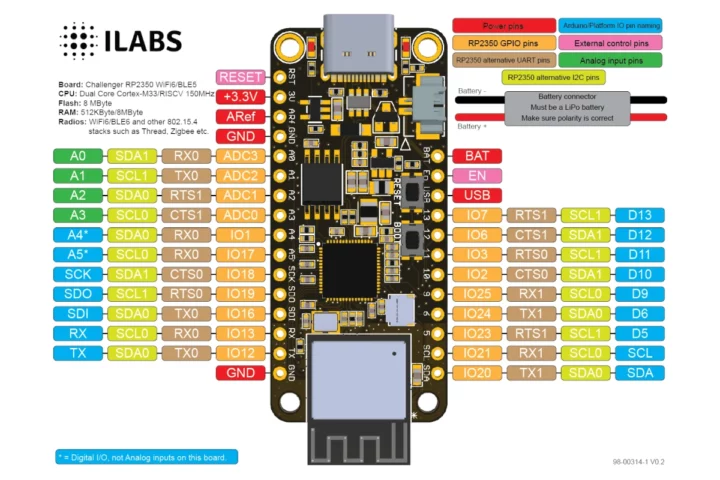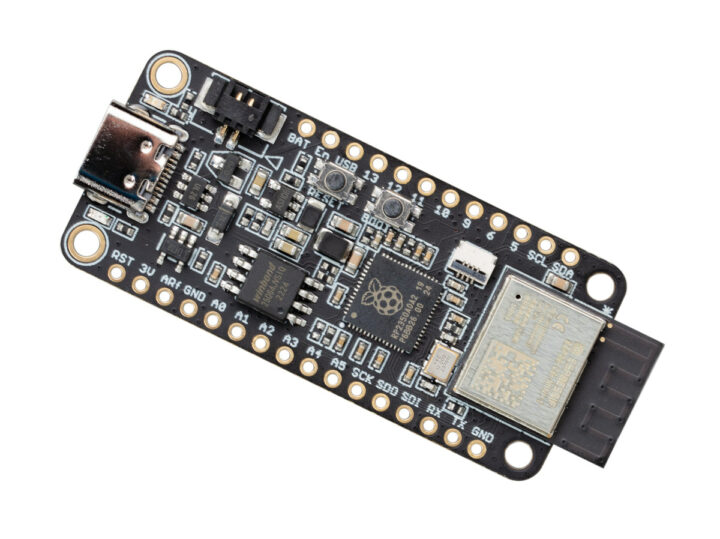You don’t need to wait for the Raspberry Pi Pico 2 W to get a Raspberry Pi RP2350 board with WiFi and Bluetooth thanks to the Challenger+ RP2350 WiFi6/BLE5 board that combines an RP2350A microcontroller with an ESP32-C6 module offering 2.4 GHz WiFi 6 and Bluetooth 5.4 LE connectivity.
The board follows the Adafruit Feather form factor with 28-pin through holes for I/Os making it compatible with FeatherWings add-on boards. It comes with a USB-C port for power and programming, and a JST connector plus a charging circuit for people wanting to connect a LiPo battery.
Challenger+ RP2350 WiFi6/BLE5 specifications:
- Microcontroller – Raspberry Pi RP2350A MCU
- CPU
- Dual-core Arm Cortex-M33 processor @ 150MHz
- Dual-core 32-bit RISC-V processor @ 150MHz
- Only two cores can be used at a given time
- Memory – 520KB internal RAM
- 8KB OTP Storage
- Package – QFN-60; 7×7 mm
- CPU
- Memory – 8MB PSRAM
- Storage – 8MB SPI flash @ 133 MHz
- Wireless Module – Espressif Systems ESP32-C6-MINI-1 connected to RP2350A over SPI and UART, plus 3x GPIO for control
- SoC – ESP32-C6H4 32-bit RISC-V microprocessor up to 160 MHz with 320KB ROM, 512KB HP SRAM, 16KB LP SRAM, 4MB flash
- Wireless
- 2.4 GHz WiFi 6 with Target Wake Time (TWT) support
- Bluetooth 5.4 LE and Mesh
- 802.15.4 radio with Zigbee, Thread, and Matter
- PCB Antenna
- USB – 1x USB 1.1 Type-C (12 Mbps) port for power, data, and programming
- Expansion
- 16-pin + 12-pin headers with
- Up to 16x GPIO
- 1x SPI, 1x I2C, 1x UART
- 4x analog inputs
- All pins can be used as PWM
- USB (5V), 3.3V, BAT, and GND
- 2x BConnect connectors (TBC, since no photo from the bottom, and I can only see one on the top)
- 16-pin + 12-pin headers with
- Misc
- Reset and Boot buttons
- Charging LED, user LED
- NEOpixel RGB LED (TBC)
- Power Supply
- 5V via USB-C port or “USB” pin (Schottky diode needed)
- 1.25mm pitch JST connector for LiPo battery
- Onboard LiPo charger with 500mA standard charge current
- Dimensions – 50.8 x 22.9 x 3.2 mm (Adafruit Feather form factor)
- Weight – 9 grams

The ESP32-C6 module is preloaded with ESP-AT firmware by default and is controlled by AT commands sent over UART from the Raspberry Pi RP2350, but also supports ESP-Hosted firmware through the SPI interface (work-in-progress). iLabs mentions support for Arduino/PlatformIO and CircuitPython for the Raspberry Pi RP2350. I’m surprised Arduino is mentioned, as other companies say it’s not available yet, but the explanation is that the Challenger+ RP2350 WiFi6/BLE5 relies on the arduino-pico-rp2350 repository currently in Alpha. Another location on the website says the board also supports the Raspberry Pi Pico C/C++ SDK, and MicroPython support is coming soon.
Additional information, including some documentation and Arduino code samples, may be found on the iLabs’ stores page where the board is sold for 249 Swedish Kronor (About $23.70 US). If you don’t need wireless connectivity, the company also introduced the Challenger+ RP2350 BConnect board available for 149 SEK or around $14.20 US.

Jean-Luc started CNX Software in 2010 as a part-time endeavor, before quitting his job as a software engineering manager, and starting to write daily news, and reviews full time later in 2011.
Support CNX Software! Donate via cryptocurrencies, become a Patron on Patreon, or purchase goods on Amazon or Aliexpress






Speaking off the hefty price tag, I guess the power consumption would also be quite high running both chip at the same time, right?
Yes
Why raspberry mcu if a esp32-c6 is present? Just because it is possible?
That’s the one reason.
another one e.g. because of PIO (Programmable IO) state machines so You can implement unusual protocols
The ESP32-C6 is an “entry-level” single-core RISC-V microcontroller while the RP2350 is more powerful, so the ESP32-C6 is only used for wireless connectivity here.
As noted by another reader, HSTX and PIO could be other reasons although SPI+DMA on ESP32-C6 boards could be used for some of the use cases (e.g. video output).
The ESP32-C6 is fine by itself, why add a RP2350?
If your microcontroller has less than 5 cores, are you really in control of your life?
Can’t use arm and riscv in parallel. Who is really in control?
Yes you can use a single ARM core and a single RISC-C core at the same time in the RP2350, that has already been established, you just can not run more than two cores at the same time, but they can be any cores.
Pico 2 doesn’t have SDIO? C6 comes with SDIO device controller to use the fullest speed when tied for high speed WiFi.
how easy is to control the C6 over AT commands? Namely using Matter to send sensor/command data from/to the RP2350?
having to use AT commands to do wifi or matter/thread seams silly, just use the esp alone or use a dual core esp32 the combination seems more hassle then it is worth.
I’ll stick my ESP32-S3. based boards
You could use the RP2040 as a APU co-processor and utilize it an for example a DSP for voice inpur noise reduction and/or audio processing for music playback.
There are many other products and project that uses the combination of an ESP32 and an XMOS xCORE chip on the board as a dedicated DSP.
There is even a project that uses RP2040 on the Raspberry Pi and a GPU.
There’s now a version with an IPEX3 antenna connector instead of a PCB antenna. This can improve the range with the right antenna, and also works with metal case through external antennas.
https://ilabs.se/product/challenger-rp2350-wifi6-ble5-ipex3/